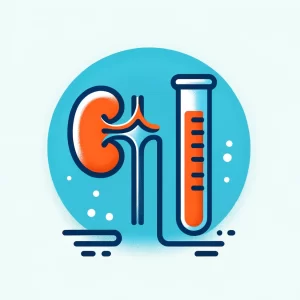The BUN Creatinine Ratio, an important lab test, sheds light on kidney function and health. This ratio, comparing Blood Urea Nitrogen (BUN) to creatinine levels, is crucial for diagnosing and managing conditions like dehydration, kidney diseases, and urinary obstructions. Understanding whether your ratio is high or low can be pivotal in guiding health decisions and treatments.
Table of Contents
- Introduction to the BUN/Creatinine Ratio Test
- Why the BUN/Creatinine Ratio Test Was Created
- How the BUN/Creatinine Ratio Relates to Health
- Use in Traditional and Functional Medicine
- Common and Uncommon Symptoms
- Why Consider the BUN/Creatinine Ratio Test
- Restoring Health with BUN/Creatinine Ratio Test Results
- Other Relevant Lab Tests
Key Takeaways
- The BUN/Creatinine Ratio is a critical indicator of kidney health.
- High or low levels of this ratio have specific health implications.
- Understanding your ratio can lead to better health management and treatment strategies.
- Quick link to order the BUN Creatinine Ratio Test.
Understanding BUN and Creatinine in the Human Body
Blood Urea Nitrogen (BUN) and creatinine are both waste products processed by the kidneys and crucial markers in assessing kidney function. BUN results from the breakdown of protein in the liver, forming urea, which is then filtered out by the kidneys. This process helps evaluate liver and kidney health and detect conditions like dehydration, kidney disease, or urinary tract issues.
Creatinine is produced from creatine, a molecule important for energy production in muscles. Unlike BUN, creatinine levels are not significantly affected by diet or hydration but reflect muscle mass. The kidneys filter almost all creatinine from the blood, making its level a consistent indicator of kidney function. Together, BUN and creatinine levels provide a comprehensive overview of kidney health and efficiency.
Introduction to the BUN Creatinine Ratio Test
The BUN/Creatinine Ratio test, a significant marker in kidney health assessments, offers vital insights into your body’s renal function. This ratio, comparing Blood Urea Nitrogen (BUN) levels to creatinine, helps healthcare professionals understand the balance and filtering capabilities of your kidneys.
Understanding the implications of high or low BUN/Creatinine ratios can guide individuals in managing their health more effectively. This test has become a staple in both traditional and functional medicine due to its reliability and comprehensiveness in kidney health evaluation.
Why the BUN/Creatinine Ratio Test Was Created
The development of the BUN/Creatinine Ratio test was driven by the need for a reliable method to assess kidney function. Initially, clinicians relied solely on separate BUN and creatinine tests, but the ratio provides a more accurate picture of kidney health.
It addresses the varying levels of muscle mass and dietary factors that can affect creatinine and BUN levels independently, offering a more nuanced understanding of renal function and its potential disorders.
How the Lab Test Relates to Your Health
Your BUN/Creatinine ratio is indicative of not just kidney health, but also your body’s overall metabolic state. Abnormal levels can hint at issues like dehydration, kidney disease, or urinary tract obstructions.
It’s crucial for diagnosing and monitoring conditions like acute or chronic renal failure, urinary tract infections, and even certain types of cancers (although not a direct test for cancer).
Restoring Health with BUN/Creatinine Ratio Test Results
Understanding your BUN/Creatinine ratio results can be a turning point in your health journey. High or low levels can guide your healthcare provider in recommending dietary changes, lifestyle modifications, or medical interventions.
These results can be a roadmap to restoring and maintaining your kidney health and overall wellbeing.
Use in Traditional and Functional Medicine
In traditional medicine, the BUN/Creatinine ratio is a standard diagnostic tool for kidney function. It’s often one of the first tests ordered when kidney issues are suspected.
Functional medicine also values this ratio, utilizing it to understand the body’s detoxification process and to tailor dietary and lifestyle interventions for optimal kidney health.
BUN, Creatinine, BUN/Creatinine Ratio, and eGFR Reference Ranges
| Lab Test | Medical Reference Range | Interpretation of Low and High Levels |
|---|---|---|
| BUN | Variable based on age and sex | High: High BUN may indicate kidney dysfunction, dehydration, heart failure, gastrointestinal bleeding, or increased protein intake. Low: Low BUN can be due to malnutrition, severe liver damage, or overhydration. |
| Creatinine | Variable based on age and sex | High: High creatinine may suggest impaired kidney function or kidney disease, muscle diseases, or dehydration. Low: Low Creatine may be due to a low muscle mass, certain dietary factors, or severe liver disease. |
| eGFR (Glomerular Filtration Rate) | >60 mL/min/1.73m2 | eGFR is an indicator of how well fluid flows through your kidneys. High: High eGFR typically, higher than normal eGFR is not a cause for concern. Low: Low eGFR indicates poor kidney function and can be a sign of kidney disease. |
| BUN/Creatinine Ratio | 10:1 to 20:1 | High: A high BUN/Creatinine ratio may suggest kidney-related diseases, congestive heart failure, urinary tract obstruction, or gastrointestinal bleeding. Low: A low BUN/Creatinine ratio may indicate conditions such as malnutrition, liver disease, sickle cell anemia, hypothyroidism, rhabdomyolysis, kidney damage or failure, or the effect of certain drugs like acetazolamide. |
Common and Uncommon Symptoms
High BUN levels can cause symptoms like fatigue, dry skin, and sleep issues, while low levels might not present noticeable symptoms. Creatinine imbalances can lead to muscle cramps, trouble sleeping, and changes in urination patterns.
However, some symptoms are less common, like a metallic taste in the mouth or severe itching, which might indicate more serious underlying issues.
Why Consider the BUN/Creatinine Ratio Test
Considering this test is crucial for early detection of kidney issues, especially for those with risk factors like hypertension or diabetes. It’s also important for individuals experiencing symptoms of kidney dysfunction.
Early detection can lead to timely intervention, potentially preventing more serious complications and preserving kidney health.
Other Relevant Lab Tests
Alongside the BUN/Creatinine ratio test, consider other kidney-related tests like a Complete Urinalysis, for a comprehensive kidney health assessment.
This test can be ordered alongside the BUN/Creatinine ratio test at TrueHealthLabs.com for a thorough understanding of your renal health.
Source: HealthMatters.io, LabTestsInfo.com
According to PubMed, the blood urea nitrogen (BUN) to creatinine ratio holds significant prognostic importance in patients with chronic heart failure. A higher BUN/creatinine ratio is linked with worse outcomes in these patients, suggesting its role in indicating underlying pathophysiological processes not captured by other conventional prognostic variables.
BUN/Creatinine Ratio FAQs
What is the BUN/Creatinine Ratio?
The BUN/Creatinine Ratio is a laboratory test that compares the levels of blood urea nitrogen (BUN) and creatinine in your blood. It’s a useful indicator of kidney function and can help diagnose various conditions related to kidney health.
Why is the BUN/Creatinine Ratio important?
This ratio is important because it helps in understanding the balance and filtration efficiency of the kidneys. Abnormal ratios can indicate kidney disorders, dehydration, and other health issues.
What does a high BUN/Creatinine Ratio mean?
A high ratio could suggest dehydration, kidney diseases, urinary tract obstruction, or gastrointestinal bleeding, among other conditions.
What does a low BUN/Creatinine Ratio indicate?
A low ratio might be a sign of conditions such as liver disease, malnutrition, or overhydration.
How can I prepare for a BUN/Creatinine Ratio test?
Generally, no special preparation is needed. However, it’s important to inform your healthcare provider about any medications you’re taking, as some can affect the test results.
Can diet affect my BUN/Creatinine Ratio?
Yes, your diet, especially protein intake, can influence BUN levels. It’s recommended to follow a balanced diet and stay hydrated.
References
- “Creatinine formation and excretion,” explained in detail on the NCBI Bookshelf, covers the biochemical processes behind creatinine production and its significance in kidney function. Available at: NCBI Bookshelf.
- The use of the blood urea nitrogen to creatinine ratio (BCR) since the 1940s in clinical practice is discussed in “Diagnostic performance of serum blood urea nitrogen to creatinine ratio” on PubMed. For more details, visit: PubMed.
- “Association of Blood Urea Nitrogen with Cardiovascular Diseases and All-Cause Mortality,” also found on PubMed, examines the role of BUN in relation to cardiovascular diseases and overall health outcomes. Read more at: PubMed.



